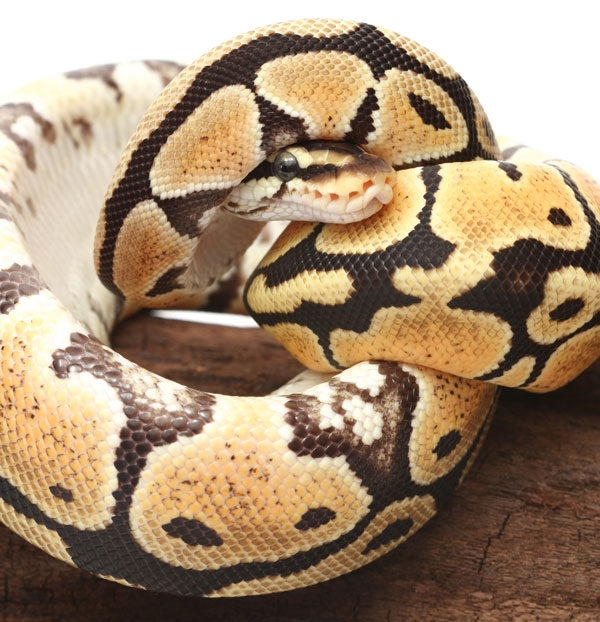Do ball pythons typically go through a hibernation state during the winter?
I am the proud owner of a ball python named Lucy. I have owned Lucy for just over one year. I have begun to worry because Lucy is not eating. I have been feeding her live mice since I have owned her. I received her as a baby and she has steadily grown. She never had a problem eating before. The normal routine for feeding is the following:
- I wait until it is night when she is more active
- I place her in a clean feeding aquarium
- I place a mouse in the aquarium
As I said, in the past this system worked fine. She would coil, strike and wrap her coils around the mouse, then eat. Now she just explores the aquarium a little, the mouse walks around and she seems very disinterested.
Handling is not a problem. She has never tried to bite me. I will hold her and she will slither up my arm and explore whatever area we sit in. I did notice on her latest shedding that her head and eye area was having a problem shedding. I purchased a shedding aid and misted her head and affected area. It seemed to help. Her eyes are not a milky white like they were, but still no interest in feeding.

Photo by Gina Cioli/I-5 Studio
Ball pythons do not hibernate, but some breeders do put them through a “brumation” or cooling down period prior to breeding season.
Is this normal? Do ball pythons typically go through a hibernation state? Her cage has a heat lamp as well as a heating pad, and she does rotate between the "hot" side of her cage and the "cool" side, even if she is not as active as she had been. If she is in a hibernation state, why did I not notice it when she was younger? Is this something that develops as these snakes mature? Any insight to put my mind at rest will help. Thank you.
Thanks for writing. It would help me if I knew for certain the temperature range that you maintain her within. For the sake of this answer, I am going to assume that you are maintaining your snake between 80 anf 85 degrees Fahrenheit during the day, with a focal basking spot of 90 degrees, and a nighttime temperature of 75 to 80 degrees. You DO have at least two thermometers in the snake’s enclosure, correct?
If you are keeping your snake within the correct temperature range, then something else is going on. Some ball pythons do stop feeding during the winter months, and this is considered a “normal” behavior. If the temperature range in the cage has not changed, then this may be more related to decreased daylight hours causing the ball python to cease feeding during the winter months. As long as the snake is not losing a lot of weight or looking emaciated, or showing any signs of illness (such as open-mouth breathing, having excess saliva, or showing other signs of respiratory disease) then this is not anything to worry about. Your ball python should begin feeding again voluntarily in late winter or early spring. Do not attempt force-feeding, as that should be the last resort.
Since the ball python is only a year old, it makes sense that last year, as a growing hatchling, it would not have experienced any winter anorexia (anorexia means not eating).
Ball pythons do not hibernate, but some breeders do put them through a “brumation” or cooling down period prior to breeding season, as this is thought to increase clutch size. You should not be concerned about bruminating the snake, who is your pet and not a breeder.
While you didn’t ask me specifically about feeding, I am not shy about offering my opinion. So far, you have been feeding live prey uneventfully, but this can be a very dangerous procedure. You should attempt to offer killed prey instead of live, as it can lead to horrible bite wounds to snakes. I’ll never forget spending months doctoring a truly rare albino ball python several years ago that had been gnawed on by a hungry rat. This rat ended up causing a tremendous amount of damage to the muscles and skin along the back, requiring long-term antibiotic therapy, multiple bandage changes and significant cost to the very upset breeder!
It is much safer to train a snake to accept either freshly killed prey or frozen/defrosted prey. Most snakes will learn to accept dead prey, especially if they are very hungry. Hunger can be a wonderful motivating tool.
If your ball python doesn’t begin feeding by spring, you should contact a herp veterinarian in your area and have the snake examined. Bring in a fresh fecal sample, if possible, during your first vet visit. Your vet may recommend blood testing and possibly radiographs (X-rays). However, I suspect the snake will begin feeding within the next few months. In the meantime, if you notice any change in behavior or signs of illness, don’t hesitate to make an appointment with your herp vet.
I hope this puts your mind at ease. This is probably normal winter anorexia.
Margaret A. Wissman, DVM, DABVP has been an avian/exotic/herp animal veterinarian since 1981. She is a regular contributor to REPTILES magazine.
Need a Herp Vet?
If you are looking for a herp-knowledgeable veterinarian in your area, a good place to start is by checking the list of members on the Association of Reptilian and Amphibian Veterinarian (ARAV) web site at www.arav.com. Look for DVMs who appear to maintain actual veterinary offices that you could contact.



